The Intel Core i9-9900K at 95W: Fixing The Power for SFF
by Ian Cutress on November 29, 2018 8:00 AM ESTCPU Performance: Office Tests
The Office test suite is designed to focus around more industry standard tests that focus on office workflows, system meetings, some synthetics, but we also bundle compiler performance in with this section. For users that have to evaluate hardware in general, these are usually the benchmarks that most consider.
All of our benchmark results can also be found in our benchmark engine, Bench.
PCMark 10: Industry Standard System Profiler
Futuremark, now known as UL, has developed benchmarks that have become industry standards for around two decades. The latest complete system test suite is PCMark 10, upgrading over PCMark 8 with updated tests and more OpenCL invested into use cases such as video streaming.
PCMark splits its scores into about 14 different areas, including application startup, web, spreadsheets, photo editing, rendering, video conferencing, and physics. We post all of these numbers in our benchmark database, Bench, however the key metric for the review is the overall score.
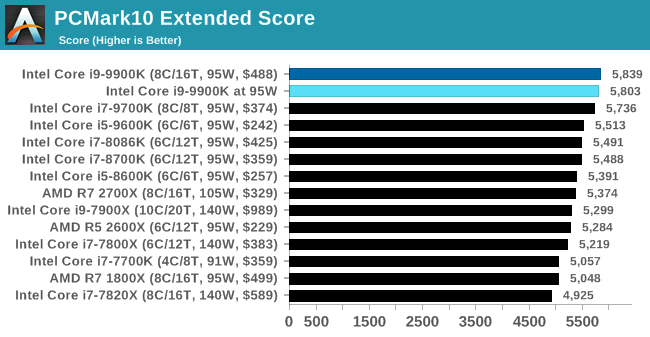
PCMark10 is more forgiving, as it has lots of pauses and only a few full-on power tests, emphasising single core speed. There isn't much lost when in 95W mode here.
Chromium Compile: Windows VC++ Compile of Chrome 56
A large number of AnandTech readers are software engineers, looking at how the hardware they use performs. While compiling a Linux kernel is ‘standard’ for the reviewers who often compile, our test is a little more varied – we are using the windows instructions to compile Chrome, specifically a Chrome 56 build from March 2017, as that was when we built the test. Google quite handily gives instructions on how to compile with Windows, along with a 400k file download for the repo.
In our test, using Google’s instructions, we use the MSVC compiler and ninja developer tools to manage the compile. As you may expect, the benchmark is variably threaded, with a mix of DRAM requirements that benefit from faster caches. Data procured in our test is the time taken for the compile, which we convert into compiles per day.
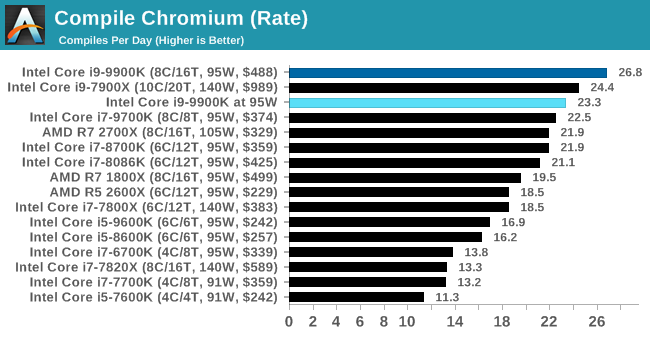
The 95W mode causes a small decrease in performance in our compile test, again moving it within a small margin to the Core i7-9700K.
3DMark Physics: In-Game Physics Compute
Alongside PCMark is 3DMark, Futuremark’s (UL’s) gaming test suite. Each gaming tests consists of one or two GPU heavy scenes, along with a physics test that is indicative of when the test was written and the platform it is aimed at. The main overriding tests, in order of complexity, are Ice Storm, Cloud Gate, Sky Diver, Fire Strike, and Time Spy.
Some of the subtests offer variants, such as Ice Storm Unlimited, which is aimed at mobile platforms with an off-screen rendering, or Fire Strike Ultra which is aimed at high-end 4K systems with lots of the added features turned on. Time Spy also currently has an AVX-512 mode (which we may be using in the future).
For our tests, we report in Bench the results from every physics test, but for the sake of the review we keep it to the most demanding of each scene: Cloud Gate, Sky Diver, Fire Strike Ultra, and Time Spy.
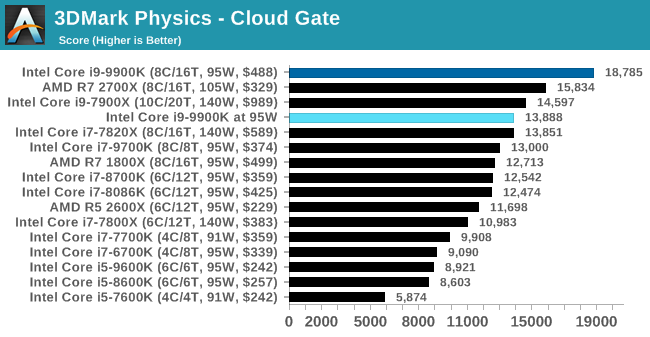


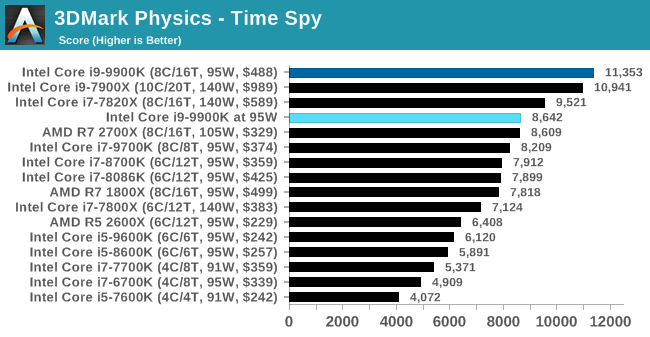
GeekBench4: Synthetics
A common tool for cross-platform testing between mobile, PC, and Mac, GeekBench 4 is an ultimate exercise in synthetic testing across a range of algorithms looking for peak throughput. Tests include encryption, compression, fast Fourier transform, memory operations, n-body physics, matrix operations, histogram manipulation, and HTML parsing.
I’m including this test due to popular demand, although the results do come across as overly synthetic, and a lot of users often put a lot of weight behind the test due to the fact that it is compiled across different platforms (although with different compilers).
We record the main subtest scores (Crypto, Integer, Floating Point, Memory) in our benchmark database, but for the review we post the overall single and multi-threaded results.
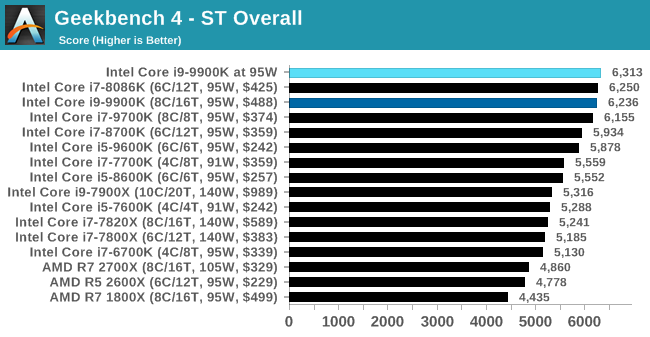











101 Comments
View All Comments
Hul8 - Friday, November 30, 2018 - link
The fact that all motherboard vendors do the exact same thing could lead one to draw the conclusion that the practice is actually mandated and suggested by Intel - unofficially of course.Higher benchmark results will look good especially for casual readers (who only look at certain performance graphs and skip the power consumption numbers), all the while allowing Intel to market them as "95 W" parts.
Alexvrb - Friday, November 30, 2018 - link
If Intel didn't like this practice they could hardcode behavior in the CPU itself. Oh wait, they DO... and they allow this because it makes them bench better. Meanwhile look at their cheaper locked "95W" models, I bet you won't see them auto-overclocking to 150W+ even with the board defaulting to "unlimited" TDP.Gastec - Wednesday, June 19, 2019 - link
It should be ILLEGAL for motherboard makers to go out of Intel's specifications by default. All overclocking should be entirely the responsibility of the user.rsandru - Thursday, November 29, 2018 - link
It's not capping, it's running the CPU according to the Intel datasheet specification.Operating the component beyond specification is usually called overclocking which is nice and all but doesn't allow an unbiased comparison of the different products.
LTC8K6 - Thursday, November 29, 2018 - link
Why not clamp it to the Intel spec?TheinsanegamerN - Thursday, November 29, 2018 - link
Because motherboards dont do that, they are letting the 9900k run wild.Alexvrb - Friday, November 30, 2018 - link
With Intel's blessing. If Intel wasn't onboard, they'd clamp the behavior on-chip, and you'd have to manually overclock to override TDP for any length of time (for unlocked chips, anyway).Anyway my prediction is that if Intel continues this practice, AMD just starts following suit more and more as time goes on. We'll see.
djayjp - Thursday, November 29, 2018 - link
So many of these tests would run better (faster and with much greater efficiency) on a highly parallel GPU instead.PeachNCream - Thursday, November 29, 2018 - link
You may have missed the point of the article.melgross - Thursday, November 29, 2018 - link
What I find interesting about all of this is that with mobile ARM chips the exact same characteristics are called throttling instead. Possibly we should get these naming conventions together? Either x86 chips throttle, as mobile ARM chips do, or mobile ARM chips have turbo mode too.